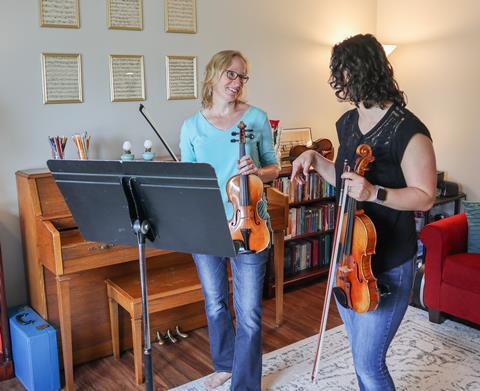Teachers need to consider an adult pupil’s past lived experiences in lessons, writes violinist Rachael Ridge

Discover more Featured Stories like this in The Strad Playing Hub
Historically, the violin has been predominantly taught to kids, sometimes as young as three to four years old, and teachers and resources are tailored towards these younger beginners. Consider two common method books used in private lesson settings: Suzuki and the Essential Elements method books. Suzuki is geared towards very young beginners who haven’t learned to read yet and the Essential Elements method books were designed for school orchestras. Teacher education programmes are also designed to equip teachers with child psychology and teaching strategies for younger students.
With more and more adults joining the ranks of violin beginners, do we as instructors need to adjust the way we teach? Do we need additional resources geared towards adult beginners specifically? Ultimately, the question is, do adult violin beginners learn differently from kids?
I would suggest that the answer is yes. Adults bring more to the table in terms of their past experiences where kids, on the other hand, are a clean slate. Adults also have more emotional, social, and physical obstacles to overcome in their violin practice. As teachers, we need to view our students as a whole person and approach each of our adult students as a unique learner.
I’ve taught several adult beginners over the years with a variety of past experiences including their depth or lack of musical knowledge, jobs, sports, social interactions that effected the way they viewed themselves, and more. Their unique backgrounds, range of skills, and familiarity with music changed the way each person approached the violin, their confidence in learning, and what specific aspects of violin learning were challenging for them.
For example, one adult I taught had never had any formal music education and was starting from scratch. He also had worked in a factory for many years and had significant physical and mental challenges to overcome at the beginning. Another adult I taught had prior musical experience on the trumpet and was able to read music proficiently. His struggle was in the frustration of knowing how to perform things mentally, but not being able to execute the skill proficiently on the violin.
Adult beginners can also struggle emotionally more than younger students and may need more support in the terms of a listening ear and honest encouragement. They carry with them anxiety learned from the difficulties of life and insecurities from the judgements of others. While kids struggle with these same issues, adults may carry a heavier burden. Also, as adult beginners tend to be a smaller community, they can feel isolated and alone in their struggles where kids have the support of their school and youth orchestras.
Social factors can also play a part in an adult’s violin experience. They may receive criticism from family and friends who don’t understand their new hobby. Even well-meaning questions from those close to us can cause adults to second guess themselves and question their abilities. Adults also can face condescension from violin professionals they encounter online or in luthier shops. This only reinforces any doubts they may already be feeling and increases their anxiety.
Finally, older students may have physical limitations due to age and learned physical habits. Years of working in a specific field, carrying themselves in a certain way, and the toll of older age can decrease their flexibility and joint mobility. This can make the body shapes and movements required to play the violin difficult to achieve and a source of frustration for students.
As teachers, we need to create an environment where adults feel welcome, safe, and free to make mistakes. We need to encourage them and give positive, constructive feedback. Adults are usually more aware of their shortcomings and may struggle with harsh criticism and yet, on the opposite spectrum, will see right through showy demonstrations of positivity.
Teachers also need to be willing to meet each student where they are at and to change direction as needed. This may require us to branch out from our traditional, comfortable methods of teaching. But, in the end, this will only help us grow ourselves. Finally, we need to be humble and willing to adjust our teaching to meet the diverse needs of our students.
Adult violin beginners are a growing population and need our support and encouragement as they tackle this beautiful instrument. Playing the violin should not be reserved for only young beginners, but instead should be enjoyed by anyone who’s willing to put in the time and effort.
Rachael Ridge is a violin teacher and runs the The Adult Violin Academy Facebook group.
Read: The importance of body awareness in violin playing: Rachael Ridge
Read: 10 tips on how to stay motivated as an adult beginner violin student
Discover more Featured Stories like this in The Strad Playing Hub
The number one source for playing and teaching books, guides, CDs, calendars and back issues of the magazine.
In The Best of Technique you’ll discover the top playing tips of the world’s leading string players and teachers. It’s packed full of exercises for students, plus examples from the standard repertoire to show you how to integrate the technique into your playing.
The Strad’s Masterclass series brings together the finest string players with some of the greatest string works ever written. Always one of our most popular sections, Masterclass has been an invaluable aid to aspiring soloists, chamber musicians and string teachers since the 1990s.
This year’s calendar celebrates the top instruments played by members of the Australian Chamber Orchestra, Melbourne Symphony, Australian String Quartet and some of the country’s greatest soloists.













































3 Readers' comments